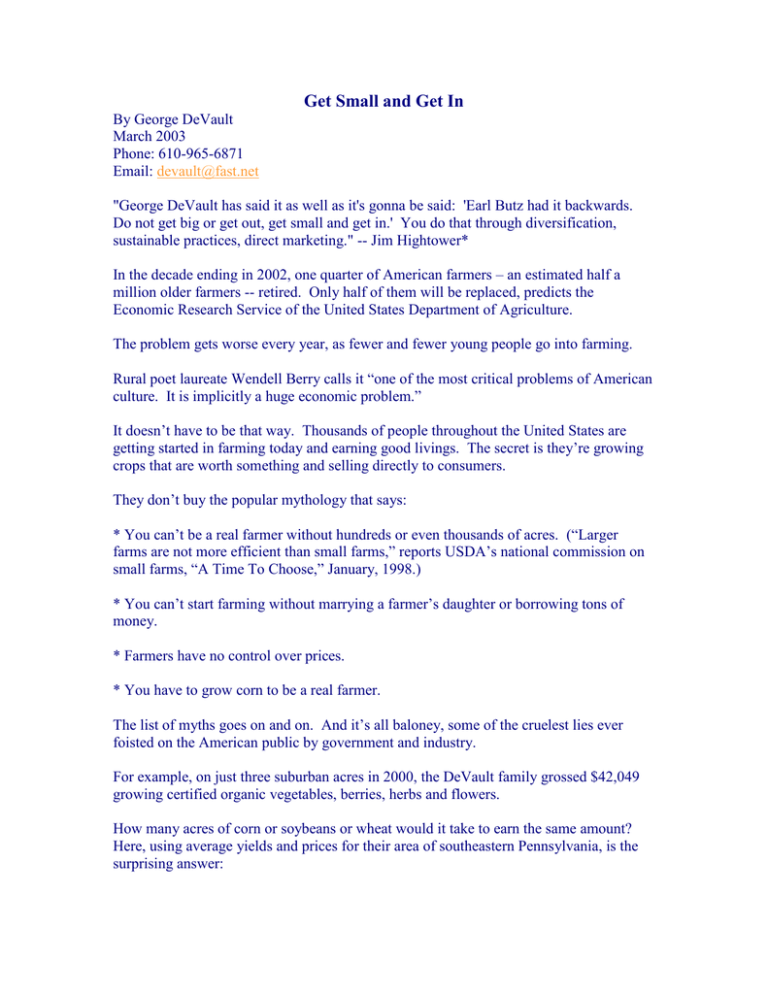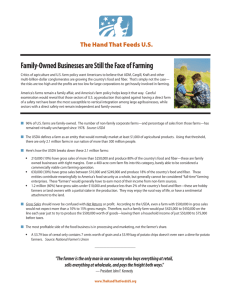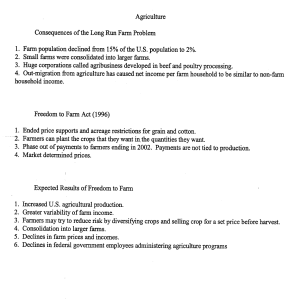Get Small and Get In
advertisement

Get Small and Get In By George DeVault March 2003 Phone: 610-965-6871 Email: devault@fast.net "George DeVault has said it as well as it's gonna be said: 'Earl Butz had it backwards. Do not get big or get out, get small and get in.' You do that through diversification, sustainable practices, direct marketing." -- Jim Hightower* In the decade ending in 2002, one quarter of American farmers – an estimated half a million older farmers -- retired. Only half of them will be replaced, predicts the Economic Research Service of the United States Department of Agriculture. The problem gets worse every year, as fewer and fewer young people go into farming. Rural poet laureate Wendell Berry calls it “one of the most critical problems of American culture. It is implicitly a huge economic problem.” It doesn’t have to be that way. Thousands of people throughout the United States are getting started in farming today and earning good livings. The secret is they’re growing crops that are worth something and selling directly to consumers. They don’t buy the popular mythology that says: * You can’t be a real farmer without hundreds or even thousands of acres. (“Larger farms are not more efficient than small farms,” reports USDA’s national commission on small farms, “A Time To Choose,” January, 1998.) * You can’t start farming without marrying a farmer’s daughter or borrowing tons of money. * Farmers have no control over prices. * You have to grow corn to be a real farmer. The list of myths goes on and on. And it’s all baloney, some of the cruelest lies ever foisted on the American public by government and industry. For example, on just three suburban acres in 2000, the DeVault family grossed $42,049 growing certified organic vegetables, berries, herbs and flowers. How many acres of corn or soybeans or wheat would it take to earn the same amount? Here, using average yields and prices for their area of southeastern Pennsylvania, is the surprising answer: * 200 acres of corn yielding 100 bushels per acre * 261 acres of soybeans yielding 35 bushels per acre * 424 acres of wheat yielding 40 bushels per acre You simply can’t make any money growing smallish plots of low-value commodities. Costs are too high. Market prices are too low. Small farms are not scaled-down big farms. To be successful, they must specialize in crops that are profitable. “Small farms are in a better position to respond ... than larger more standardized farming operations. They provide urban people with a social connection to farming, farmers, and rural people and a healthy, fresh food supply,” adds USDA’s small farm commission. George DeVault, editor of The New Farm magazine in the United States and Russia for more than 20 years, has seen diversification, high-value crops and direct marketing work not just on his own farm, but on hundreds of farms he has visited in 15 countries on three continents over the last two decades. Anyone with clear vision and good marketing skills can farm successfully today: * On a little land, whether they buy or rent, borrow or barter. That’s true in the country -in suburbia -- or even in the big city. * Without much money. You don't have to max out a credit card or even visit a bank. You can use "other people's money" and pay cash for everything as you go. The key is developing a guaranteed market that pays you in advance. * Without much equipment. A borrowed garden tiller and push seeder were all DeVault started with. * By growing in the "off season" when prices are highest. Simple, low-cost high tunnels (minimally heated greenhouses) can keep you in production through spring, fall and even winter. * By selling directly to consumers and bypass all of the middlemen, who make most of the profits in agriculture today. Deal directly with growing number of people who are simply fed up with tired, tasteless supermarket produce. That's true even of today's high-priced organic produce. While it may be grown without pesticides, it's still shipped across the country – or even half way around the world! It's jetlagged by the time it reaches health food stores and upscale markets. Local produce is always farm-fresh, crisp and tasty. No one can ever beat local growers on freshness and taste. In these uncertain economic times, a diversified small farm can take the sting out of being "downsized,” help you supplement your income, pay off your mortgage early, get out of debt, build a cash cushion or retire early from the rat race. You can create real wealth by investing in things of real and lasting value -- land, greenhouses and farm equipment -- instead of playing roulette with a stock portfolio or 401(K). “The food sector of the economy is second only to the pharmaceutical sector in terms of return on investment,” according to USDA. Yet farmers relying on traditional crops and markets are going broke, receiving only 19 percent of the food dollar -- down from 37 cents in just 1980, says USDA. Diversified small farms are changing all of that, providing farmers with a living wage, consumers with better, fresher food and the nation with real homeland security. * Keynote address Pennsylvania Association for Sustainable Agriculture Farming for the Future Conference, Feb, 2001




